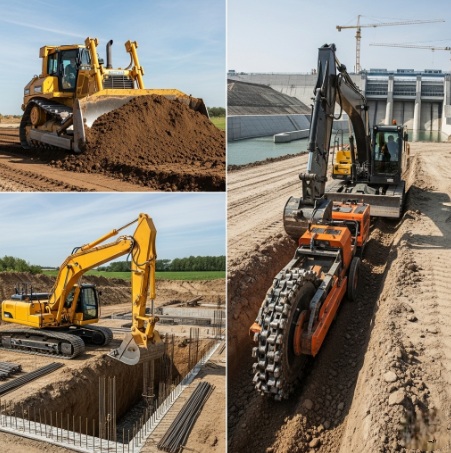Every civil engineering project, from building a simple road to a massive dam, starts with one crucial step: moving earth. We need to dig, push, and shape the ground to prepare the site for construction. This is where excavating plants in different civil projects play a vital role. These powerful machines are the workhorses of the construction industry, each designed for a specific task. Let’s explore how these machines transform landscapes for different types of projects.

Bulldozers and Excavators in Road and Highway Construction
Building new roads and highways requires a lot of earthmoving. The process typically begins with clearing the site and leveling the ground. A bulldozer, with its large, heavy blade, is perfect for this initial work. It pushes away trees, rocks, and topsoil, creating a clear path for the road. After the initial clearing, excavators take over. These versatile machines have a large bucket at the end of a movable arm, and they are essential for creating embankments and digging drainage ditches. They precisely scoop up soil and place it where it’s needed, helping to create the correct slope and elevation for the road surface.
As construction progresses, smaller trenches are often needed for laying utility lines, like telecommunication cables or drainage pipes. For this job, a trencher is the most efficient machine. It cuts a narrow, continuous trench in the ground, making it easy to lay cables and pipes neatly alongside the new road. The use of these specialized machines ensures that the road is not only built correctly but is also properly supported by the surrounding landscape and infrastructure.
Large-Scale Earthmoving for Dams and Reservoirs
Dam and reservoir projects are massive undertakings that require moving an enormous amount of soil and rock. Engineers and construction crews must dig deep into the earth to create a solid foundation for the dam and to shape the vast area that will become the reservoir. For these projects, you need the biggest and most powerful excavating plants.
Draglines and large hydraulic excavators are the main players here. A dragline is a huge machine with a long arm and a bucket that is “dragged” across the ground to scoop up material. These machines are excellent for open-pit mining and large-scale excavation because they can move massive volumes of soil and rock in a single pass. Similarly, large hydraulic excavators are used to dig the foundation for the dam wall itself and to shape the landscape of the future reservoir. Their powerful hydraulic systems can break and move even the toughest rock, making them indispensable for such challenging projects.
Foundation and Basement Digging: The Role of Excavators
Every building, whether it’s a small house or a large skyscraper, needs a solid foundation. This often means digging a large, deep hole. This is a job for an excavator, specifically a backhoe, which is an excavator mounted on the back of a tractor-like vehicle. It’s perfect for urban environments and smaller sites where space is limited.
The operator of an excavator must be very precise. They must dig the hole to the exact depth and dimensions specified by the architectural plans. This is a critical step because the stability of the entire building depends on a properly dug foundation. A skilled operator uses the machine’s controls to carefully remove soil and create a level, stable base for the concrete foundation to be poured. This precision ensures that the building will stand strong for many years.
Trenchers and Mini-Excavators for Urban Infrastructure
Working in a busy city presents unique challenges. Spaces are tight, and a network of existing underground pipes and cables already exists. When it comes to installing new pipelines or repairing old ones, you need small but powerful machines. Trenchers and mini-excavators are the ideal choices for this job.
Mini-excavators are compact and can fit into narrow streets and small construction sites without causing major disruption. Their small size does not mean they are less powerful; they can still dig deep and accurately. Similarly, trenchers are crucial for digging precise trenches for laying cables and pipes. Operators must work carefully to avoid hitting existing utility lines, which can be dangerous and costly. These specialized machines make it possible to perform complex underground work with minimal impact on the urban environment.
References
- Schaefer, R. (2018). Construction Site Engineering: The Ultimate Guide. Prentice Hall.
- Smith, J. (2019). Heavy Machinery in Civil Engineering. McGraw-Hill Education.
For further reading on how excavating plants are used in different civil projects, you can visit the Journal of Construction Engineering and Management.
Leave a Reply